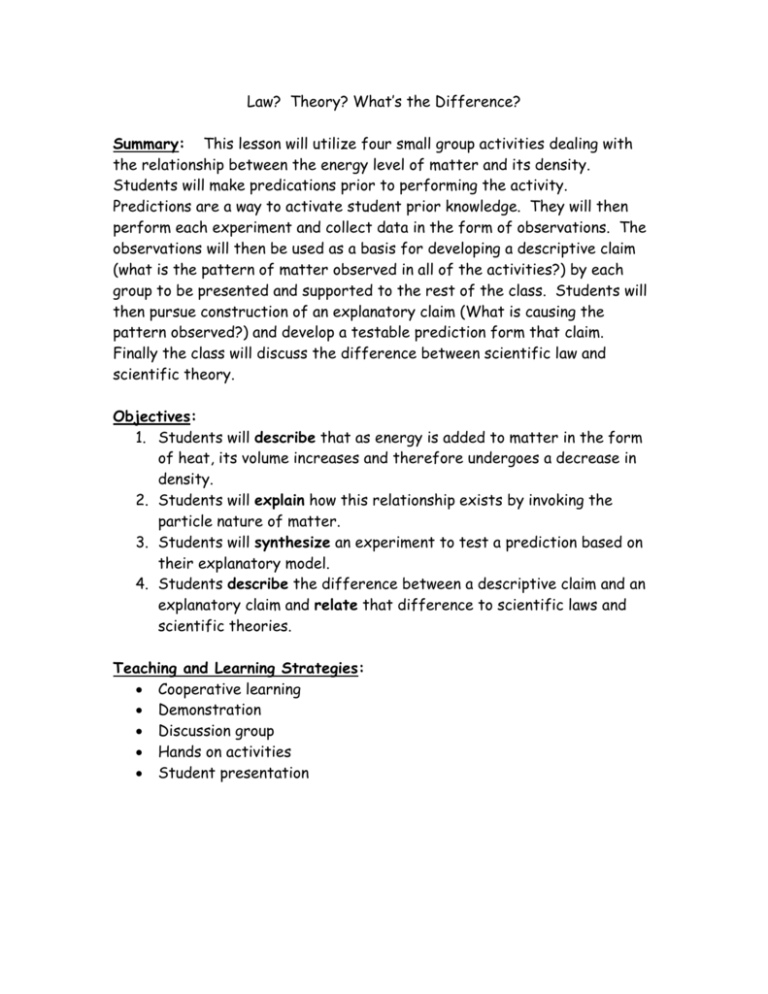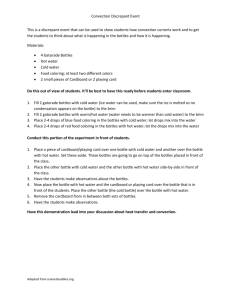lesson-plan_law-and-theory
advertisement

Law? Theory? What’s the Difference? Summary: This lesson will utilize four small group activities dealing with the relationship between the energy level of matter and its density. Students will make predications prior to performing the activity. Predictions are a way to activate student prior knowledge. They will then perform each experiment and collect data in the form of observations. The observations will then be used as a basis for developing a descriptive claim (what is the pattern of matter observed in all of the activities?) by each group to be presented and supported to the rest of the class. Students will then pursue construction of an explanatory claim (What is causing the pattern observed?) and develop a testable prediction form that claim. Finally the class will discuss the difference between scientific law and scientific theory. Objectives: 1. Students will describe that as energy is added to matter in the form of heat, its volume increases and therefore undergoes a decrease in density. 2. Students will explain how this relationship exists by invoking the particle nature of matter. 3. Students will synthesize an experiment to test a prediction based on their explanatory model. 4. Students describe the difference between a descriptive claim and an explanatory claim and relate that difference to scientific laws and scientific theories. Teaching and Learning Strategies: Cooperative learning Demonstration Discussion group Hands on activities Student presentation Materials and Resources: 1. Big Thermometer a. 50ML volumetric flask b. Hot plate c. Water d. Red food coloring 2. Up, up and away a. Large plastic trash bag b. Heat gun c. Extension cord d. Duct tape 3. Tip of the iceberg a. 250ML beaker b. Water c. Ice cubes d. Blue food coloring 4. Convection in a bottle a. 4 wide moth glass juice bottles b. Hot water c. Cold water d. Blue and yellow food coloring e. Two laminated cards 5. Paper work a. “Law-Theory” Venn diagram b. Written procedures to each activity Performing the lesson: 1. Activate student prior knowledge of scientific law and theory by having them complete the “Law-Theory” Venn diagram. 2. Discuss that they will visit four locations in which they will perform one activity. They are to read the directions at that location, perform the activity, note all observations and then move to the next location. 3. When students have visited all four stations, reconvene and student groups will work on developing an over-arching claim that describes the pattern they witnessed in matter among all of the stations. 4. Groups present their claim and support it with evidence to the rest of the class. 5. Whole class discussion can occur to ameliorate any “controversies.” 6. Have groups now synthesize an explanatory claim. This would be one that explains why the pattern they described earlier is happening. 7. Based on this explanatory claim, students should devise a prediction and develop and experiment that could be used to test that prediction. 8. Finally there should be a discussion about the difference between their descriptive and explanatory claims and how that relates to scientific laws and theories, where descriptive claims are analogous to scientific laws and explanatory claims are analogous to scientific theories. 9. Other NOS issues such as bias and creativity should also make their way into the discussion. The activities Big Thermometer 1. 2. 3. 4. 5. 6. Read all directions first. Write a prediction of you think will happen. Place 50ml of red water in the Erlenmeyer flask. Place flask on hot plate. Plug in and turn on hot plate. Observe the flask and its contents for about 5 minutes. DO NOT let the water boil. 7. Record all observations as diagrams, text, or both. 8. Turn off/unplug hot plate and dump water in sink. 9. Discuss whether your observations paralleled your prediction. 10. Move on to the next station. Before heating After heating Up, Up, and Away 1. Read all directions first. 2. Write down a prediction of what you think will happen. 3. Turn heat gun on high (It should be sitting on the floor pointing straight up.) 4. Place the open garbage bag, upside down, over the heat gun. This works best if two hold the bottom against the floor and the third holds the top up. It is important to keep the bag from getting too close to the heat gun, as the heat gun is very, well, hot. 5. After a couple of minutes, when the bag looks to be expanded to capacity, everyone let go of the bag at once. 6. Record all of your observations as diagrams, text, or both. Discuss whether your observations paralleled your prediction. 7. Move on to the next station. Tip of the Iceberg 1. 2. 3. 4. Read all directions first. Write down a prediction of what you think will happen. Place an ice cube in a beaker of water. Place one or two drops of blue food coloring on the ice cube, near its edge. 5. Use white paper as a background against which to look. 6. Record all observations as diagrams or text or both. 7. Move on to the next station. Ice Water Food coloring Density currents Convection in a Bottle 1. Fill two large-mouth, glass juice bottles with hot water and add yellow food coloring. Fill two bottles with cold water (ice water preferable) and add blue food coloring. 2. In a clear plastic container place one cold (blue) and one hot (yellow) water bottle side by side. 3. Using a laminated card for each bottle, invert the cold water bottle onto the hot water bottle, and repeat with the hot water bottle on top of the cold water bottle. This is the “start” position. 4. Have students make a prediction about what they think will happen when you remove the cards from between the bottles. 5. Carefully remove the cards so the bottles are still standing upside down on top of the other bottle and the waters are allowed to mix. 6. Have students take notes on their observations. 7. Allow about 5 minutes for reaction to take place. Cold (blue) water Laminated card Hot (yellow) water Warm (green) water Before removing cards After removing cards







